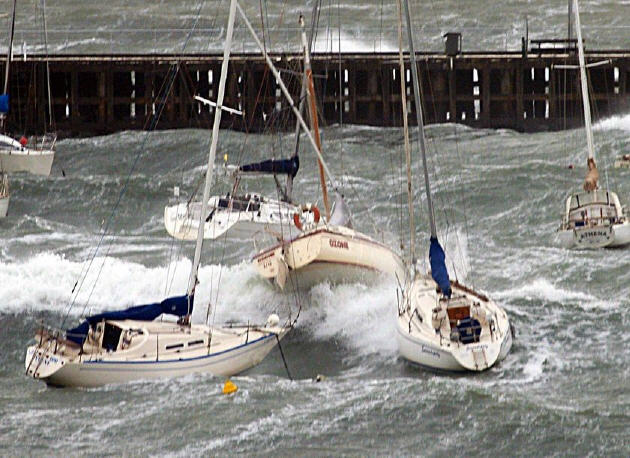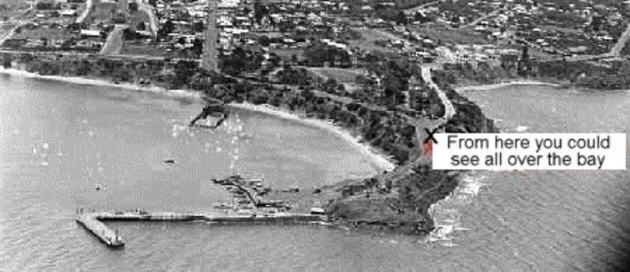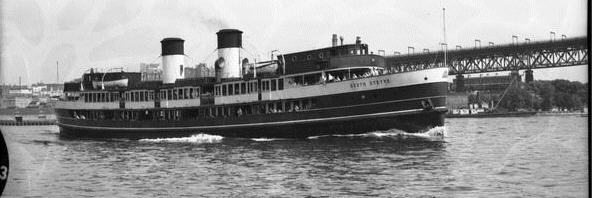
Mornington Harbour in a April 2008 storm. In these conditions, even the best laid moorings give way, and the pier took a terrible hiding.
Photo courtesy ABC news.
As a youth, I had always dreamed of living by the sea, and Mornington for me was a dream come true. Some towns have happening places, and “The Mornington Pier” was one of those places. It was built out from Schnapper Point, and the name alone made the promise of a good fishing spot. There was always something going on. At one time a colony of Penguins took up residency under the pier to the delight of the local kids, and for a while a seal claimed the pier as his domain.
Old Mister Werner used to come on the bus several times a week and would fish there all night. He was always ready for a yarn, and there was plenty of action during the summer months at the sailing club. Even in the winter when the westerly storms came, plenty of people would come down to the hard stand to watch the waves break over the pier. There was much discussion as to how much it moved, and how much more punishment the pier could take before something came adrift, and it collapsed completely.
Some years before, the pier had a leg that ran out to the west, but this was later removed and the pier was extended to the north. The water was quite deep and the maintenance high.
I had gone down for a look while some piles were being replaced on the piers outer end, and was surprised to see that three piles had to be spliced together to get enough length in the deep water. No wonder that it moved so much in big waves.
My “Flying Fifteen” was left moored out in the harbour during the sailing season and I spent quite a few uncomfortable nights down at the pier during a storm, watching in case the boat broke its moorings and came ashore.
On my way down to the sailing club I was in the habit of stopping at the top of the hill to have a look around. One could see for miles over the bay. If the You Yang Mountains to the west some sixty kilometres away stood out clear on the horizon, there was a good chance that we were in for a spell of fine weather, and In the summer this was the separation point where the new evening easterly breeze off the beach met the dying left over southerly breeze in a distinct line across the point, and many a race was lost by misjudging the wind direction here.

A very old photo of the pier, showing the leg off the end that was later removed, and you can clearly see the point where the left over southerly wind
met the evening breeze coming out of the harbour from the north east.
After lunch, on one particularly hot still day I watched a light plane out over the water to the North. It was doing aerobatics, diving down quite low before it pulled out of its dive, and then back up to do some more rolls and loops. Then to my surprise on the next dive it just disappeared into the water. I kept staring at where it had disappeared, and it took some time to realise that the plane had crashed and sunk almost immediately. For a minute everything out on the water seemed frozen. Then some boats that had been out fishing, and one that had been towing a water skier, headed to where the aeroplane had disappeared. It eventuated that a well known Melbourne underworld figure had been flying the plane and rumours of the cause of the crash abounded.
One very hot windy Sunday morning during the Christmas holidays I was rather surprised to see what looked like a small passenger liner approaching from the North. No large commercial passenger vessels used the pier at that time, and this one was approaching with the strong northerly wind astern. I waited to see what was happening. The ship came alongside the east side of the pier, and it appeared that a deck hand up forward managed to get a line across to a bollard, but the stern was a long way off, and couldn’t be secured. The boat’s stern, with the strong north wind now blowing across the starboard quarter, started to swing out towards the eastern shore. No crew on board seemed to move, and there appeared to be no passengers on board.
The ship was the ferry “South Steyne” some seventy meters long and it seemed to fill the whole harbor. I thought at the time that she would simply go in to reverse and get clear, but no, the stern just kept swinging towards the boats moored in the three lanes out off the fisherman’s jetty. No one seemed to know what to do, and then a figure appeared on the lower deck with an axe. It was a quick thinking member from the sailing club who had been standing on the pier.
Several minutes elapsed before it became obvious that the ferry could no longer go astern; it had swung too far. It was now facing west and would soon be lying at right angles to the pier. If she went astern now she would run in to what was left of the old sea baths, or the red bluff.

The steam driven “South Steyne” had a history of problems with stopping. Her history is worth reading.
Photo thanks to the National library of Australia.
It happened that the first boat in the way of the ferry was a Flying Fifteen, and as it was being overrun, the bow went down and the stern with the whole rudder showing was up in the air, and the only person visible on board was chopping away with an axe at the rope mooring line. At this time I realised that if this continued my boat would be in the firing line in a few minutes. I ran down to the fisherman’s jetty and swam out to my boat lying on the second line of moorings, managed to swing aboard, drop the mooring, and under bare mast sailed down behind the fisherman’s jetty and out of harm’s way.
Boats that had been freed from their moorings were now drifting down the harbour and had to be fended off the boats moored on the north side of the fisherman’s jetty. A group of onlookers feverishly helped handle the drifting boats around to the lee side and secured them. Everyone was too busy to notice what was happening with the ferry, and by the time all were safe “South Styne” was turned around and heading north back up the bay with smoke belching from one of her funnels.
I never could work out how the “South Steyne” managed to turn back the way she came without reversing, or doing a lot more damage in the harbor. Did she have twin propellers, and may be able to operate one in reverse, and the other in forward? I would love to know! In searching for some photos of the ferry I came across some details of a series of collisions, and problems she had with stopping, including several run-ins with naval ships on Sydney Harbour, and she even managed to demolish a shed on the end of a wharf in Sydney, but as far as I know, never did attempt to berth at Mornington again.
“South Steyne” had been built in Scotland, she sailed to Sydney in 1938. There she was the pride of the harbour fleet for many years. It surprises me that she was powered by steam and not diesel having been built when she was. During her varied career she did spend some time in Melbourne as a floating restaurant, but was not popular. She then spent several years in Newcastle, returned to Sydney where she caught fire, was refitted, spent time in Darling Harbour as Sydney’s 2,000 Olympic information centre, and now seventy plus years after her launching, is serving out her years as a restaurant moored in Sydney Harbour.